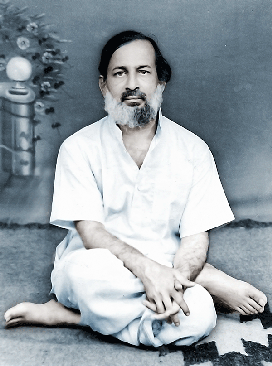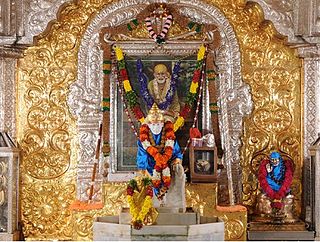
Meher Baba was an Indian spiritual master who said he was the Avatar, or God in human form, of the age. A major spiritual figure of the 20th century, he had a following of hundreds of thousands of people, mostly in India, but with a significant number in the United States, Europe and Australia.

Sai Baba of Shirdi, also known as Shirdi Sai Baba, was an Indian spiritual master and fakir, considered to be a saint, revered by both Hindu and Muslim devotees during and after his lifetime.

Sathya Sai Baba was an Indian guru. At the age of fourteen he claimed that he was the reincarnation of Shirdi Sai Baba, and left his home to serve his devotees.

Fakir is an Islamic term traditionally used for Sufi Muslim ascetics who renounce their worldly possessions and dedicate their lives to the worship of God. They do not necessarily renounce all relationships and take vows of poverty, some may be poor and some may even be wealthy, but the adornments of the temporal worldly life are kept in perspective and do not detract from their constant dedication to God. The connotations of poverty associated with the term relate to their spiritual neediness, not necessarily their physical neediness.

Mahavatar Babaji is the name given to his guru by Indian yogi Yogiraj Lahiri Mahasaya (1828-1895), and several of his disciples, who reportedly appeared to them between 1861 and 1935, as described in various publications and biographies. According to Yogananda's autobiography, Babaji has resided for at least hundreds of years in the remote Himalayan regions of India, seen in person by only a small number of disciples and others.

Upasani Maharaj, born Kashinath Govindrao Upasni, was an Indian spiritual teacher, considered by his disciples to be a satguru. He lived in Sakori, British India, and is said to have received God-realization from Sai Baba of Shirdi. Upasani himself was one of the principal spiritual teachers of Meher Baba.
Perfect Master is the English term Meher Baba began to use in his writing as early as 1925 to denote the Eastern idea of a sadguru (Vedanta) or a qutub (Sufism). A Perfect Master, according to Baba, is a God-realized person who can use his Divine attributes of Infinite Power, Knowledge and Bliss for the spiritual upliftment of others. In describing Meher Baba's specialized use of the term Charles Purdom writes, "The title ‘Perfect Master’ ... means one who has himself reached the goal to which he directs others: one who, pointing to God, has himself realized God."
The Sathya Sai Baba movement is a new religious movement inspired by South Indian Neo-Hindu guru Sathya Sai Baba who taught the unity of all religions. Some of his followers have faith in his claim to be a purna Avatar of Shiva and Shakti, who is believed to have been predicted in the Bhagavad Gita. This means that some of his followers see him as a God. Devotees engage in singing devotional songs called "bhajans" and selfless service (seva). Its official organization is the Sathya Sai Organization. However the Sathya Sai Baba movement extends beyond the organization. An important aspect of the faith of adherents is the miracles attributed to Sathya Sai Baba. The number of adherents is estimated between 6 and 100 million.

The Shirdi Sai Baba movement is the religious movement of the followers and devotees of the 19th- and early 20th-century Indian saint Sai Baba of Shirdi. Sai Baba is a muslim fakir and a Hindu baba known for his divine powers and miracles.
Ganesh Srikrishna Khaparde was an Indian lawyer, scholar, political activist and a noted devotee of Shirdi Sai Baba and saint Gajanan Maharaj.
Yogi Ramsuratkumar was an Indian saint and mystic. He was also referred to as "Visiri samiyar" and spent most of his post-enlightenment period in Tiruvannamalai, a small town in Tamil Nadu which is famous for attracting spiritual seekers worldwide and has had a continuous lineage of enlightened souls. He acknowledges the contribution of three of the most well known saints of his time in his evolution to enlightenment. These individuals were Sri Aurobindo, the founder of Integral yoga, Ramana Maharshi, one of the "spiritual supermen" of his time, and Swami Ramdas, Yogi's eventual guru.
Events in the year 1835 in India.

Sri Acharya Ekkirala Bharadwaj Swamy Varu, was a Dattatreya incarnation and who authored many Hindu spiritual books, primarily on the life and worship of Shirdi Sai Baba and Sri Dattatreya. He is well known as "Sri Sai Master". He had born in the Bharadwajasa gotra like SriPada Swamy and Sri Shirdi Sai Baba. He is the fourth son of Sri Ekkirala Ananthacharya and Srimathi Buchamma. Sri Ekkirala Bharadwaj written Telugu-language book Sri Sai Leelamrutham is one of the famous book. Sri Ekkirala Bharadwaja later translated the book to English with the name Sai Baba The Master which is also a popular one. He also wrote "Sri Guru Charitra" in English and Telugu. He also has written many spiritual books in Telugu and English.
Pavhari Baba (1798-1898) was a Hindu ascetic and saint. He was born in Premapur, Jaunpur in a Brahmin family. In his childhood he went to Ghazipur to study under the tutelage of his uncle who was a follower of Ramanuja or Shri sect. After finishing his studies he travelled to many places. At Girnar in Kathiawar he was initiated into Yoga.

Swami Nigamananda Paramahansa was an Indian yogi, guru and mystic well known in Eastern India. He is associated with the Shakta tradition and viewed as a perfect spiritual master of vedanta, tantra, yoga and prema or bhakti. His followers idealized him as their worshipped and beloved thakura.

Sri Sai Gurucharitra is a biography on the life of Sai Baba of Shirdi, written by his devotee Ganpatrao Dattatreya Sahasra-buddhe, better known as Das Ganu Maharaj.

Shirdi Sai is a 2012 Indian Telugu-language biographical film, produced by A.Mahesh Reddy on AMR Sai Krupa Entertainments banner, directed by K. Raghavendra Rao. Starring Nagarjuna as the 19th-20th century spiritual guru Sai Baba of Shirdi who lived in western India, it is the cinematic depiction of some of his landmark life episodes, his teachings and his way of life. Music was composed by M. M. Keeravani. Shirdi Sai was released worldwide on 6 September 2012, and has received mixed to positive reviews while Nagarjuna received critical acclaim for his performance in the titular role with most reviewers hailing this as one of his career best performances.

Swami Swaroopanand Saraswati was an Indian religious leader. In 1982, he became the Shankaracharya of Dwarka Sharada Peetham in Dwaraka, Gujarat and also caretaker of the Jyotir Math in Badrinath.
Aur is a town in Jalandhar district of Punjab, India which is located on the Nawanshahr to Phillaur National Highway. Aur is connected with a number of cities including Phillaur, Nawanshahr, Banga, and Rahon. It is located 12 km (7.5 mi) from District Shaheed Bhagat Singh Nagar. Aur is a block of 83 villages which is located 101 km From Punjab capital Chandigarh.

Sri Naga Sai Mandir is a Hindu temple dedicated to the Indian Spiritual Master Shirdi Sai Baba in Coimbatore in the Indian state of Tamil Nadu.












